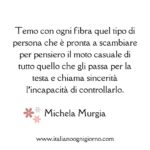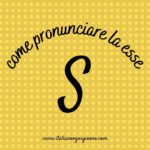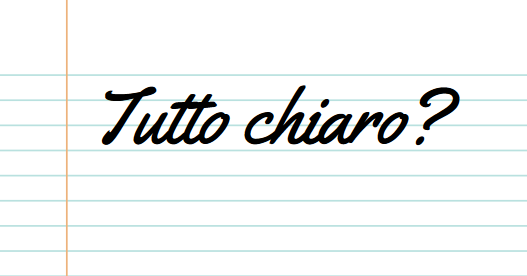A challenge for many Italian students is learning how to use tutto, tutti, tutta, tutte correctly. This simple explanation will help you master them.
There’s a quiz waiting for you to make sure that è tutto chiaro, everything is clear.
1. “Tutto” by itself means “everything”
• Tutto andrà bene. (Everything is going to be alright.)
• Ho fatto tutto. (I did everything.)
2. Tutto/tutta in front of nouns mean “the whole…”, “the entire…”
• Abbiamo mangiato tutta la torta. (We ate the whole cake.)
• Abbiamo trascorso tutto il mese insieme. (We spent the whole month together.)
• Hai visto tutta la partita? (Did you see the whole match?)
3. Tutti by itself means “everyone”/”everybody”
• Tutti vanno in spiaggia durante l’estate. (Everyone goes to the beach during the summer.)
• Ho comprato regali per tutti. (I bought gifts for everyone.)
4. Tutti/tutte (followed by a noun) mean “all of (something)” or even “every one of (something)”
• Ho visto tutti i film di Fellini. (I’ve seen all of Fellini’s films.)
• Luca ha parlato con tutte le ragazze della festa . (Luca talked to all of the girls at the party.)
• Tutti i giorni studio in biblioteca. (I study at the library every day.)
Also, remember that tutto/tutti is masculine (singular/plural) and tutta/tutte is feminine (singular/plural).
Now you’re ready for the quiz!
Tutto chiaro? Try the quiz
Quiz-summary
0 of 8 questions completed
Questions:
- 1
- 2
- 3
- 4
- 5
- 6
- 7
- 8
Information
Inizia il quiz!
You have already completed the quiz before. Hence you can not start it again.
Quiz is loading...
You must sign in or sign up to start the quiz.
You have to finish following quiz, to start this quiz:
Results
0 of 8 questions answered correctly
Your time:
Time has elapsed
You have reached 0 of 0 points, (0)
| Average score |
|
| Your score |
|
Categories
- Not categorized 0%
-
Ottimo lavoro!
- 1
- 2
- 3
- 4
- 5
- 6
- 7
- 8
- Answered
- Review
-
Question 1 of 8
1. Question
1 pointsT___ andrà bene.
Correct
Incorrect
-
Question 2 of 8
2. Question
1 pointsHai letto t____ il libro?
Correct
Incorrect
-
Question 3 of 8
3. Question
1 pointsAngelo mangia sempre t_____ la sua pappa.
Correct
Incorrect
-
Question 4 of 8
4. Question
1 pointsT_____ sono andati a sciare questo fine settimana.
Correct
Incorrect
-
Question 5 of 8
5. Question
1 pointsT_____ le domeniche vado a pranzo dai nonni.
Correct
Incorrect
-
Question 6 of 8
6. Question
1 pointsMetterò in ordine t_____!
Correct
Incorrect
-
Question 7 of 8
7. Question
1 pointsSabato vado sempre al supermercato e faccio t_____ la spesa per la settimana.
Correct
Incorrect
-
Question 8 of 8
8. Question
1 pointsNon ho visto t_____ i film di Pietro Germi.
Correct
Incorrect
- Il Discorso diretto e discorso indiretto in italiano

- I massacri delle foibe – Il Giorno del Ricordo

- Un racconto di Natale: Il Tesoro dei Poveri di Gabriele D’Annunzio

- Estate di San Martino- leggenda e tradizioni

- I verbi fraseologici: venire/andare a prendere

- Michela Murgia: tenace scrittrice e attivista italiana

- I Vini italiani |Storia e Cultura

- Come diventare migliori comunicatori in italiano

- 3 ways to pronounce the s in Italian



Grazie, questa è stato bene.
Prego, Lois!
One important thing that is missing: tutto/tutti is masculine; tutta/tutte is feminine.
Yes, that’s correct.
In the pdf that you can download I go more into detail and explain the masculine and feminine.
Buono quiz
Thank you. Such a simple answer to what has been a complicated issue for me.
Prego! I’m very happy that it was helpful!
Grazie. Mi ho piacuto molto.
Short, simple, to the point. Just what I needed!
Prego Cathy!
I’m happy it was helpful.